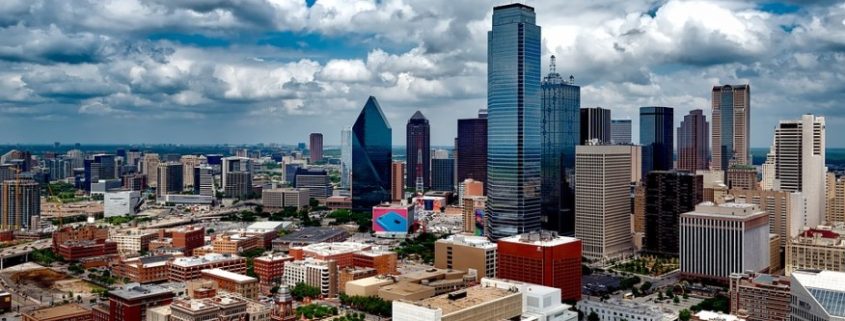Texas-Style Urbanism Wooing Millions to Lone Star State

A new reports says more Americans are moving to the state for plentiful jobs and affordable housing.
They say everything’s bigger in Texas, and now it appears that economic opportunity falls into that category. Texas cities are attracting millions from around the U.S. and the world with the promise of decent-paying jobs, affordable homes and entrepreneurial opportunity, according to a new study.
“The Texas Way of Urbanism,” a new report from the Center for Opportunity Urbanism (COU), a Houston, Texas based think tank, details the rise of Texas cities. The Lone Star state’s major urban areas provide unprecedented upward mobility, eclipsing the great cities of the coasts, it says. Among the report’s findings:
- While many urban pundits look to places like New York, San Francisco and Portland as future models for American cities, the large urban areas that have added the most jobs and people since 2000 are overwhelmingly in Texas.
- Most U.S. cities are more like Texas cities – dispersed, reasonably priced, liberally regulated – than like older cities on the coasts. Urban policies that worked for the great cities of the past aren’t necessarily going to work for the great cities of the present and future.
- Urban policy should be defined not by one approach, particularly one cooked in D.C., but by bottom up strategies reflecting the basic DNA of our very diverse regions.
The success of Texas cities depends on the prosperity not just of the rich but the middle and working class residents who are now flocking there. Soaring housing prices and stagnant job growth are driving middle class families out of the coastal “glamour cities.”
“Texas attracts investors, entrepreneurs, researchers, inventors, and workers who recognize a state committed to reducing barriers to economic success and to creating the financial, educational, and physical conditions for growth and upward mobility,” observes Henry Cisneros, former Housing and Urban Development secretary under the Clinton administration, an author of the report.
The report chronicles the rapid transformation of the Lone Star State from a largely agricultural and commodities-producing state to a highly urbanized and economically sophisticated state attracting millions from all over the world. The so-called Texas Triangle, which includes Dallas-Fort Worth, Houston, Austin and San Antonio, today accounts for 66 percent of the state’s population and 77 percent of its GDP. The region, with its 53 Fortune 500 companies, ranks among the nation’s fifth strongest nationwide, according to urban scholar Richard Florida.
“The future of American cities can be summed up in five letters: Texas,” observe COU executive director Joel Kotkin and Wendell Cox in the report. “The metropolitan areas of the Lone Star state are developing rapidly. These cities are offering residents a broad array of choices — from high density communities to those where the population is spread out — and a wealth of opportunities.”
Since 2000, jobs in Dallas and Houston have multiplied by nearly one-third (31 percent), three times the rate of New York City and five times the rate of Los Angeles. Furthermore, less-populous Austin and San Antonio can boast a 52.1 percent increase – some of the fastest job growth nationwide.
Not all growth came in the form of low-end low-paid jobs. Those paying between 80 and 200 percent of national median wage have seen substantial growth – including 39 percent in Austin, 26 percent in Houston and 21 percent in Dallas, a much greater clip than San Francisco (6 percent), New York (3 percent) and Los Angeles (4 percent).
High-paid tech (STEM) jobs in Texas cities also grew at rate higher than those of rival metro areas, especially in Austin (45 percent) and San Antonio (29 percent). Texas’ largest metro areas – Houston and Dallas – lost out to San Francisco on this front with jobs hikes of 22 percent and 17 percent, respectively, compared to the Bay Area’s 26 percent. Nonetheless, they still exceeded the 10 percent national average and far surpassed New York City’s 2 percent and Los Angeles’ 0 percent. Chicago actually lost ground on this front with a 3 percent decrease in job growth.
Affordable homes prove an important component to the Texas model of urbanism. Lone Star State cities tend to have much lower housing costs, compared to their rivals on the coasts. In 2015, median housing costs were from three to four times higher than median income in the Texas Triangle, compared to eight and nearly six times the median income in Los Angeles and New York City, respectively. Only Chicago ranks near Texan cities in terms of housing affordability.
One key indicator of economic opportunity — foreign immigration – grew faster in Texas than most of its rivals. From 2000 to 2014, more than 1.6 million foreign-born citizens landed in the Lone Star state, slightly less than in California but 60 percent more in proportion to Texas’ population. During the same period, the Latino population soared by 90 percent in Austin and 75 percent in Dallas-Fort Worth and Houston, compared to 17 percent in Los Angeles.
Click here to read the complete report.
About the Author
Jennifer Goodman is Senior Editor at BUILDER and has 17 years of experience writing about the construction industry. She lives in the walkable urban neighborhood of Silver Spring, Md. Connect with her on Twitter at @Jenn4Builder.


